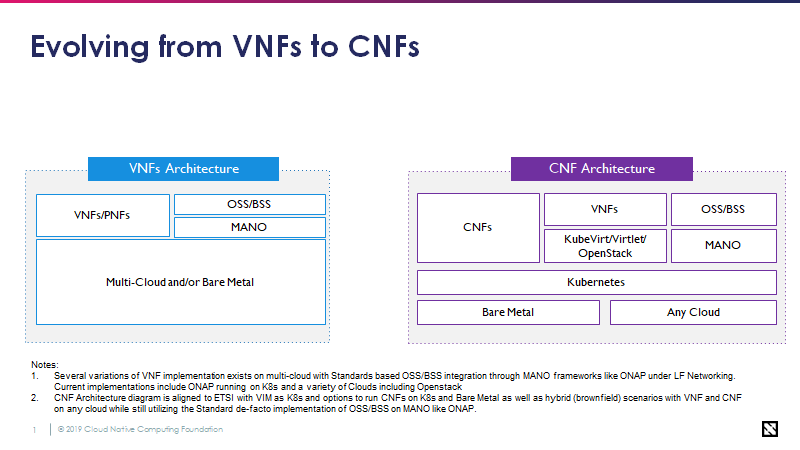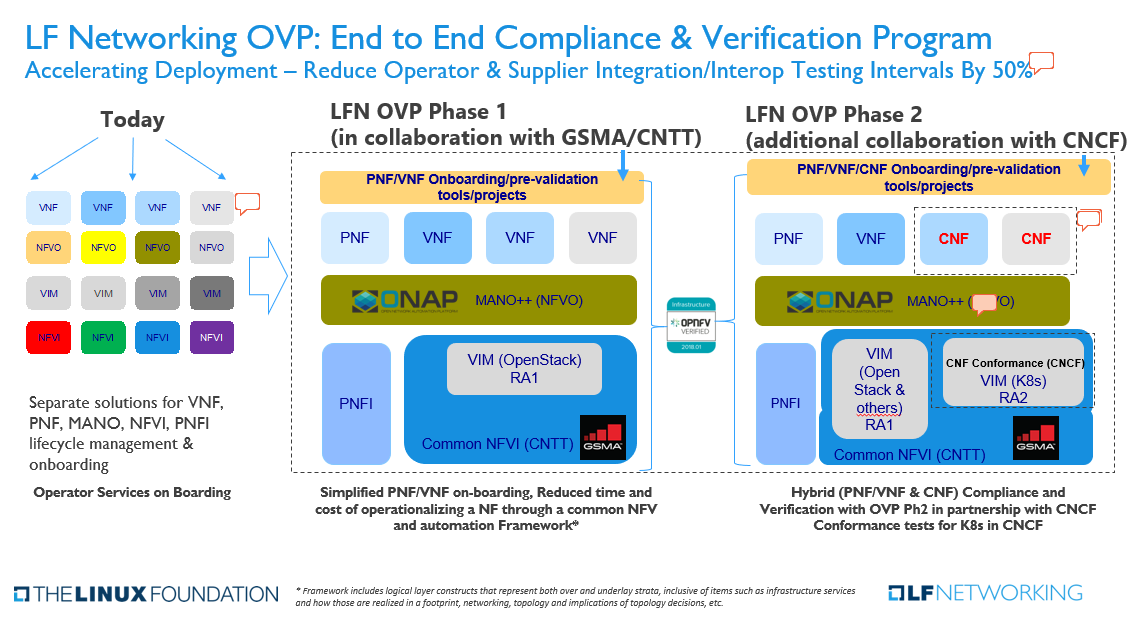All members are encouraged to contribute directly into this working draft.
Charter
The LFN OPNFV Verification Program Phase 2 (OVP 2.0) is an open source, community-led compliance and verification program to promote, enable, and evolve a thriving ecosystem of cloud-native telecoms where Cloud Native Network Functions (CNFs) from different vendors can inter-operate and run on the same immutable infrastructure. It includes CNF compliance and verification testing based on requirements and best practices put forth by both the CNCF and CNTT. These requirements feed tool-sets and testing scripts developed within OPNFV, ONAP and CNCF communities.
Linux Foundation ecosystem relationships to OVP 2.0
(Olivier - Include Rabi's overview diagram illustrating relationships between the different contributing organizations highlighting open questions on who does what.)
The evolving architecture from VNFs to CNFs
(Olivier - Add short description and I would like to gain clarity around CNF orchestration. Specifically, we should clarify that CNFs are to be orchestrated by Kubernetes and that MANO is utilized specifically for VNFs. If this is not the case, why? Add clarity to the CNF Architecutre below.
Source: LF Networking
Compliance & Verification Program
OVP2.0 E2E Compliance and Verification Program adds additional collaboration with the CNCF in the testing and verification of Cloud Native Network Functions.
Catherine - comments and questions regarding the E2E Compliance & Verification Slide (below):
#1 CNF Conformance has been removed from the CNF boxes in alignment with the CNF Conformance definition - https://github.com/cncf/cnf-conformance
#2 VIM (Openstack) and VIM (K8S) are part of CNTT NFVI boxes in alignment with https://github.com/cntt-n/CNTT/tree/master/doc/ref_arch
#3 NFVi, PFNi → NFVI, PFNI – spelling aligned with ETSI
#4 Remove "for CNFs and" from "Hybrid (PNF/VNF & CNF) Compliance and Verification with OVP Ph2 in partnership with CNCF Conformance tests for CNFs and for K8s in CNCF'
Additional changes to be made:
#5 Picture under "Today" should include PNF, not only VNF
Questions:
#6 Reduce Testing Intervals by 50% - How "50%" have been determined?
#7 MANO++ - is it to confirm that ONAP is Mano++ meaning that ONAP is providing additional capabilities than Mano functions i.e. Control Loops, etc.?
Source: LF Networking
Verification and Certification Process
OPV 2.0 will provide an open source test suite which enables both open and closed source CNFs to demonstrate conformance and implementation of cloud-native practices. Compliance to the verification process will result in a LFN Cloud Native CNF badge(s). The LFN CNF badges should provide value for both operators and commercial vendors.
(We should outline the types of testing as well as clarify where these tests belong. Workload testing, Platform testing, etc.)
Cloud Native Network Function (CNF) Best Practices Criteria
Propose that the below should be aligned, agreed, and later decomposed into testable items. We should sort with mandatory first and optional (but still verifiable) criteria at the end. Organize into levels of Gold, Silver, Bronze if this makes sense. What will the value of a Bronze be for operators and vendors?
CNF Best Practice Criteria | |
1 | CNFs are decomposed into loosely coupled collection of services (e.g. use micro-services design). |
2 | Micro-services should, where possible, be independent of the host operating system. |
3 | Micro-services should utilize well defined declarative APIs |
4 | Micro-services should be designed with a clean separation between stateful and stateless services (have separation of state storage and business logic) |
5 | Clear separation should exist between micro-services (e.g. use of containers) |
6 | Micro-services should provide a mechanism to verify container content. Containers should not require root level permissions. It should be possible to secure API access to a micro-service using common methods. |
7 | Micro-services should be resilient (self-healing and distributed)
|
8 | Micro-services should be elastic (vertical and horizontal scaling in response to load)
|
9 | Micro-services should be dynamic - where possible, have a small footprint and fast startup time enabling efficient use of resources and rapid scaling. |
10 | Micro-services may utilize a service mesh for service-to-service communication over a network |
11 | Micro-service/Container life-cycle is managed by an orchestrator (e.g. K8s) |
12 | Micro-services utilize immutable infrastructure: |
A |
|
B |
|
C |
|
D |
|
E |
|
F |
|


